Scoot's Low-Cost Carrier Strategy Analysis
VerifiedAdded on 2021/04/21
|18
|4041
|321
AI Summary
The assignment provides an in-depth analysis of Scoot's competitive strategy in the low-cost carrier market. It examines the company's core competencies, cost leadership and differentiation strategies, as well as its ability to produce new products and services using innovative marketing approaches through social media channels. The document also discusses Scoot's competitors, such as AirAsia and Jetstar, and highlights the company's brand image and emotional engagement with customers. The analysis is based on various sources, including academic papers, industry reports, and company publications.
Contribute Materials
Your contribution can guide someone’s learning journey. Share your
documents today.
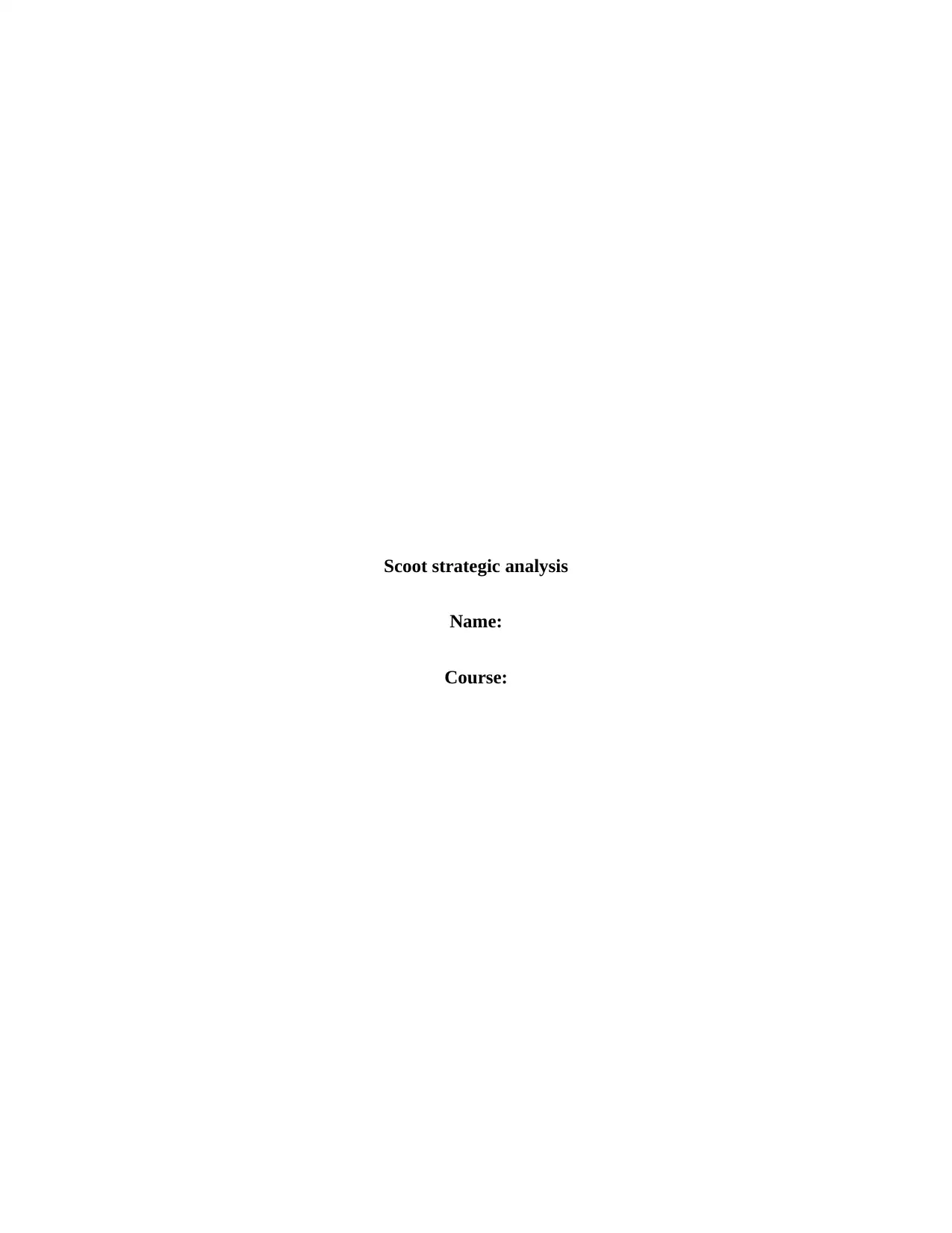
Scoot strategic analysis
Name:
Course:
Name:
Course:
Secure Best Marks with AI Grader
Need help grading? Try our AI Grader for instant feedback on your assignments.
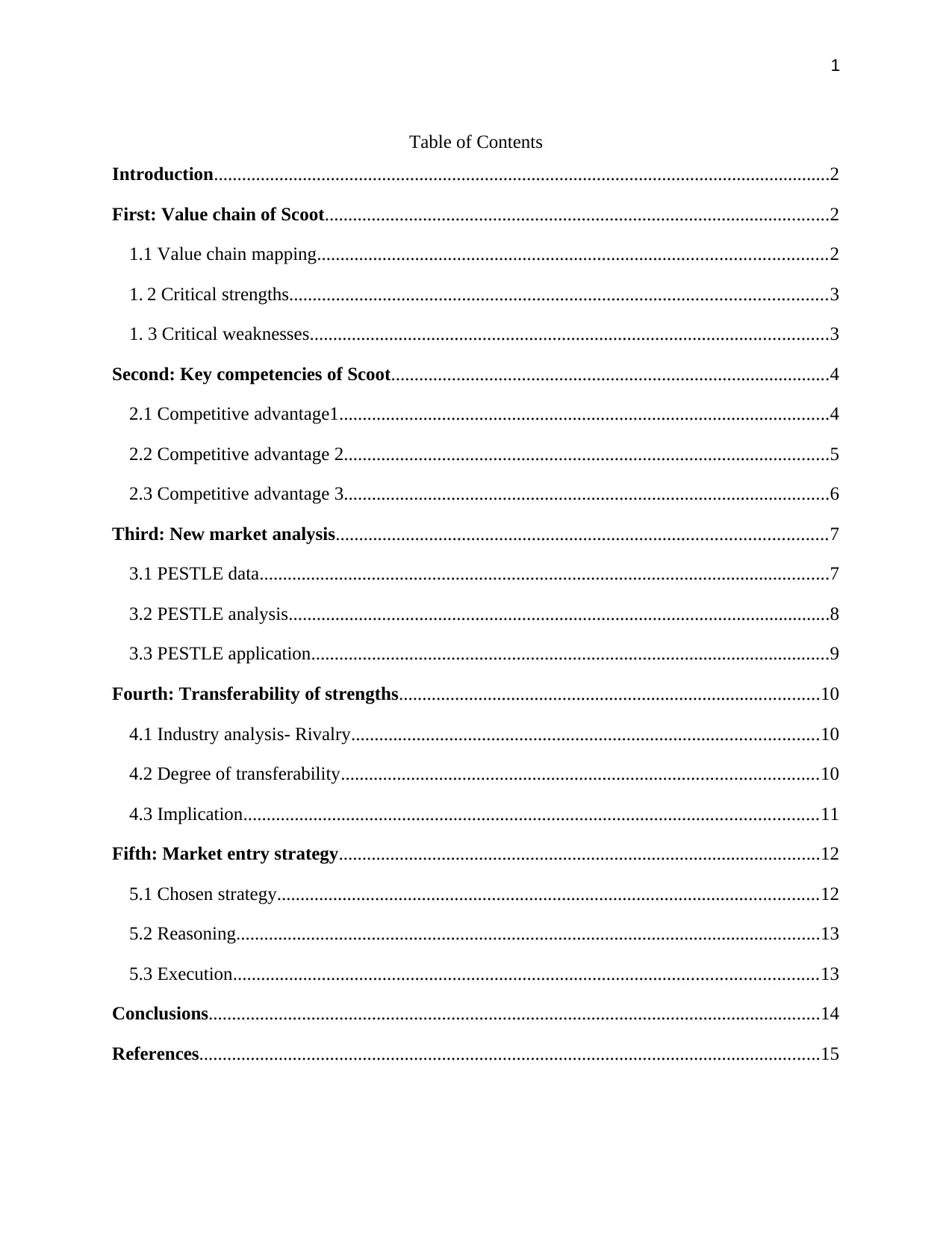
1
Table of Contents
Introduction....................................................................................................................................2
First: Value chain of Scoot............................................................................................................2
1.1 Value chain mapping.............................................................................................................2
1. 2 Critical strengths...................................................................................................................3
1. 3 Critical weaknesses...............................................................................................................3
Second: Key competencies of Scoot..............................................................................................4
2.1 Competitive advantage1.........................................................................................................4
2.2 Competitive advantage 2........................................................................................................5
2.3 Competitive advantage 3........................................................................................................6
Third: New market analysis.........................................................................................................7
3.1 PESTLE data..........................................................................................................................7
3.2 PESTLE analysis....................................................................................................................8
3.3 PESTLE application...............................................................................................................9
Fourth: Transferability of strengths..........................................................................................10
4.1 Industry analysis- Rivalry....................................................................................................10
4.2 Degree of transferability......................................................................................................10
4.3 Implication...........................................................................................................................11
Fifth: Market entry strategy.......................................................................................................12
5.1 Chosen strategy....................................................................................................................12
5.2 Reasoning.............................................................................................................................13
5.3 Execution.............................................................................................................................13
Conclusions...................................................................................................................................14
References.....................................................................................................................................15
Table of Contents
Introduction....................................................................................................................................2
First: Value chain of Scoot............................................................................................................2
1.1 Value chain mapping.............................................................................................................2
1. 2 Critical strengths...................................................................................................................3
1. 3 Critical weaknesses...............................................................................................................3
Second: Key competencies of Scoot..............................................................................................4
2.1 Competitive advantage1.........................................................................................................4
2.2 Competitive advantage 2........................................................................................................5
2.3 Competitive advantage 3........................................................................................................6
Third: New market analysis.........................................................................................................7
3.1 PESTLE data..........................................................................................................................7
3.2 PESTLE analysis....................................................................................................................8
3.3 PESTLE application...............................................................................................................9
Fourth: Transferability of strengths..........................................................................................10
4.1 Industry analysis- Rivalry....................................................................................................10
4.2 Degree of transferability......................................................................................................10
4.3 Implication...........................................................................................................................11
Fifth: Market entry strategy.......................................................................................................12
5.1 Chosen strategy....................................................................................................................12
5.2 Reasoning.............................................................................................................................13
5.3 Execution.............................................................................................................................13
Conclusions...................................................................................................................................14
References.....................................................................................................................................15
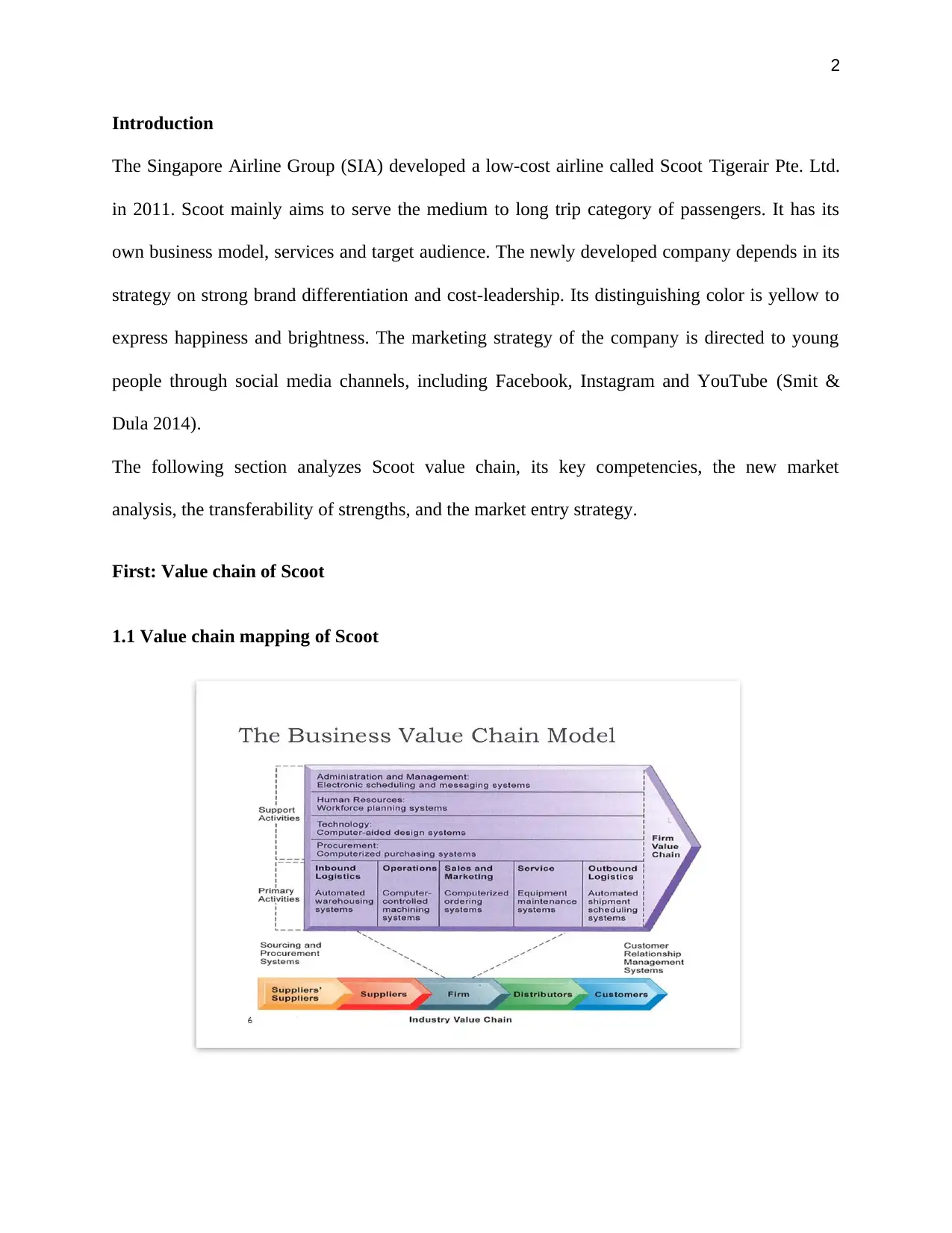
2
Introduction
The Singapore Airline Group (SIA) developed a low-cost airline called Scoot Tigerair Pte. Ltd.
in 2011. Scoot mainly aims to serve the medium to long trip category of passengers. It has its
own business model, services and target audience. The newly developed company depends in its
strategy on strong brand differentiation and cost-leadership. Its distinguishing color is yellow to
express happiness and brightness. The marketing strategy of the company is directed to young
people through social media channels, including Facebook, Instagram and YouTube (Smit &
Dula 2014).
The following section analyzes Scoot value chain, its key competencies, the new market
analysis, the transferability of strengths, and the market entry strategy.
First: Value chain of Scoot
1.1 Value chain mapping of Scoot
Introduction
The Singapore Airline Group (SIA) developed a low-cost airline called Scoot Tigerair Pte. Ltd.
in 2011. Scoot mainly aims to serve the medium to long trip category of passengers. It has its
own business model, services and target audience. The newly developed company depends in its
strategy on strong brand differentiation and cost-leadership. Its distinguishing color is yellow to
express happiness and brightness. The marketing strategy of the company is directed to young
people through social media channels, including Facebook, Instagram and YouTube (Smit &
Dula 2014).
The following section analyzes Scoot value chain, its key competencies, the new market
analysis, the transferability of strengths, and the market entry strategy.
First: Value chain of Scoot
1.1 Value chain mapping of Scoot
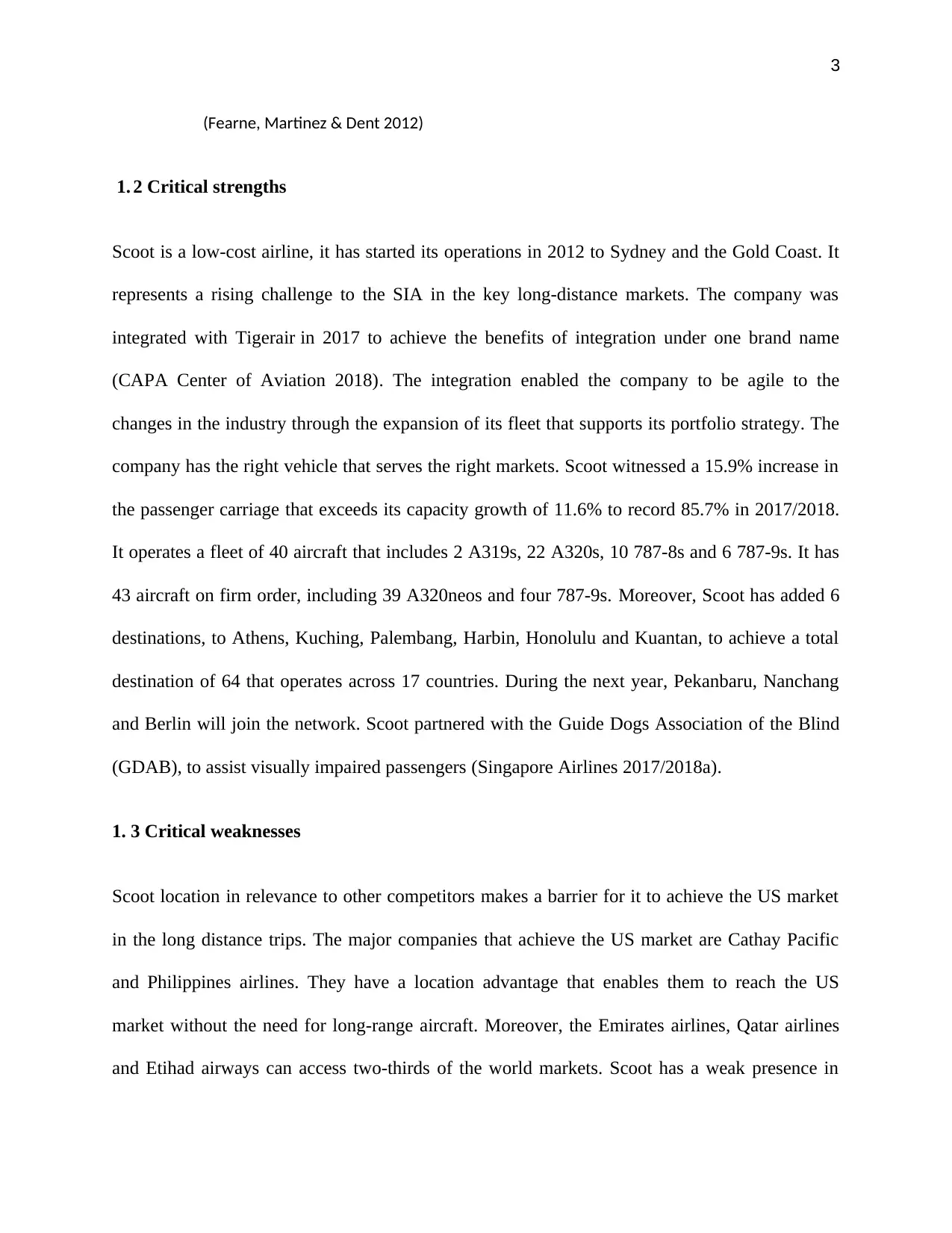
3
(Fearne, Martinez & Dent 2012)
1. 2 Critical strengths
Scoot is a low-cost airline, it has started its operations in 2012 to Sydney and the Gold Coast. It
represents a rising challenge to the SIA in the key long-distance markets. The company was
integrated with Tigerair in 2017 to achieve the benefits of integration under one brand name
(CAPA Center of Aviation 2018). The integration enabled the company to be agile to the
changes in the industry through the expansion of its fleet that supports its portfolio strategy. The
company has the right vehicle that serves the right markets. Scoot witnessed a 15.9% increase in
the passenger carriage that exceeds its capacity growth of 11.6% to record 85.7% in 2017/2018.
It operates a fleet of 40 aircraft that includes 2 A319s, 22 A320s, 10 787-8s and 6 787-9s. It has
43 aircraft on firm order, including 39 A320neos and four 787-9s. Moreover, Scoot has added 6
destinations, to Athens, Kuching, Palembang, Harbin, Honolulu and Kuantan, to achieve a total
destination of 64 that operates across 17 countries. During the next year, Pekanbaru, Nanchang
and Berlin will join the network. Scoot partnered with the Guide Dogs Association of the Blind
(GDAB), to assist visually impaired passengers (Singapore Airlines 2017/2018a).
1. 3 Critical weaknesses
Scoot location in relevance to other competitors makes a barrier for it to achieve the US market
in the long distance trips. The major companies that achieve the US market are Cathay Pacific
and Philippines airlines. They have a location advantage that enables them to reach the US
market without the need for long-range aircraft. Moreover, the Emirates airlines, Qatar airlines
and Etihad airways can access two-thirds of the world markets. Scoot has a weak presence in
(Fearne, Martinez & Dent 2012)
1. 2 Critical strengths
Scoot is a low-cost airline, it has started its operations in 2012 to Sydney and the Gold Coast. It
represents a rising challenge to the SIA in the key long-distance markets. The company was
integrated with Tigerair in 2017 to achieve the benefits of integration under one brand name
(CAPA Center of Aviation 2018). The integration enabled the company to be agile to the
changes in the industry through the expansion of its fleet that supports its portfolio strategy. The
company has the right vehicle that serves the right markets. Scoot witnessed a 15.9% increase in
the passenger carriage that exceeds its capacity growth of 11.6% to record 85.7% in 2017/2018.
It operates a fleet of 40 aircraft that includes 2 A319s, 22 A320s, 10 787-8s and 6 787-9s. It has
43 aircraft on firm order, including 39 A320neos and four 787-9s. Moreover, Scoot has added 6
destinations, to Athens, Kuching, Palembang, Harbin, Honolulu and Kuantan, to achieve a total
destination of 64 that operates across 17 countries. During the next year, Pekanbaru, Nanchang
and Berlin will join the network. Scoot partnered with the Guide Dogs Association of the Blind
(GDAB), to assist visually impaired passengers (Singapore Airlines 2017/2018a).
1. 3 Critical weaknesses
Scoot location in relevance to other competitors makes a barrier for it to achieve the US market
in the long distance trips. The major companies that achieve the US market are Cathay Pacific
and Philippines airlines. They have a location advantage that enables them to reach the US
market without the need for long-range aircraft. Moreover, the Emirates airlines, Qatar airlines
and Etihad airways can access two-thirds of the world markets. Scoot has a weak presence in
Secure Best Marks with AI Grader
Need help grading? Try our AI Grader for instant feedback on your assignments.

4
China because of the economic barriers and regulations. China has high market entry barriers
and uses low price strategies to prevent new entrants from accessing its market even when the
demand for low-cost seat increases (SWOT and PESTEL 2017).
The raising of fuel prices represents a threat to Scoot business activities because it depends on
the cost leadership strategy. The increasing prices of fuel increase the airfares and the operating
costs. Moreover, most of the planes will continue to depend on the fuel for decades (Singapore
Airlines 2017/2018b).
Another problematic issue is the absence of the real information about the demand for low-cost
seats. There are seasons where the demand increases and other seasons where the demand
decreases for this category of transportation services. The absence of accurate information makes
it difficult for Scoot to estimate the most demanding markets that need to be served (Dobruszkes
2013).
Second: Key competencies of Scoot
2.1 Competitive advantage1
Scoot has intangible elements that are difficult to be imitated by competitors. The organizational
operations support the core competencies of the cost-effective services (Heracleous & Wirtz
2009). The engineering operations and the modification of the engines, enhanced their
performance and resulted in fuel savings. The ground operations were developed to include
mobile power units and night pre-conditioned air units to save power which saves fuel
consumption. Moreover, the implementation of the Centre of Gravity Optimization improves the
fuel efficiency of the aircraft operations. In addition, the improvement in the fleet operations
China because of the economic barriers and regulations. China has high market entry barriers
and uses low price strategies to prevent new entrants from accessing its market even when the
demand for low-cost seat increases (SWOT and PESTEL 2017).
The raising of fuel prices represents a threat to Scoot business activities because it depends on
the cost leadership strategy. The increasing prices of fuel increase the airfares and the operating
costs. Moreover, most of the planes will continue to depend on the fuel for decades (Singapore
Airlines 2017/2018b).
Another problematic issue is the absence of the real information about the demand for low-cost
seats. There are seasons where the demand increases and other seasons where the demand
decreases for this category of transportation services. The absence of accurate information makes
it difficult for Scoot to estimate the most demanding markets that need to be served (Dobruszkes
2013).
Second: Key competencies of Scoot
2.1 Competitive advantage1
Scoot has intangible elements that are difficult to be imitated by competitors. The organizational
operations support the core competencies of the cost-effective services (Heracleous & Wirtz
2009). The engineering operations and the modification of the engines, enhanced their
performance and resulted in fuel savings. The ground operations were developed to include
mobile power units and night pre-conditioned air units to save power which saves fuel
consumption. Moreover, the implementation of the Centre of Gravity Optimization improves the
fuel efficiency of the aircraft operations. In addition, the improvement in the fleet operations
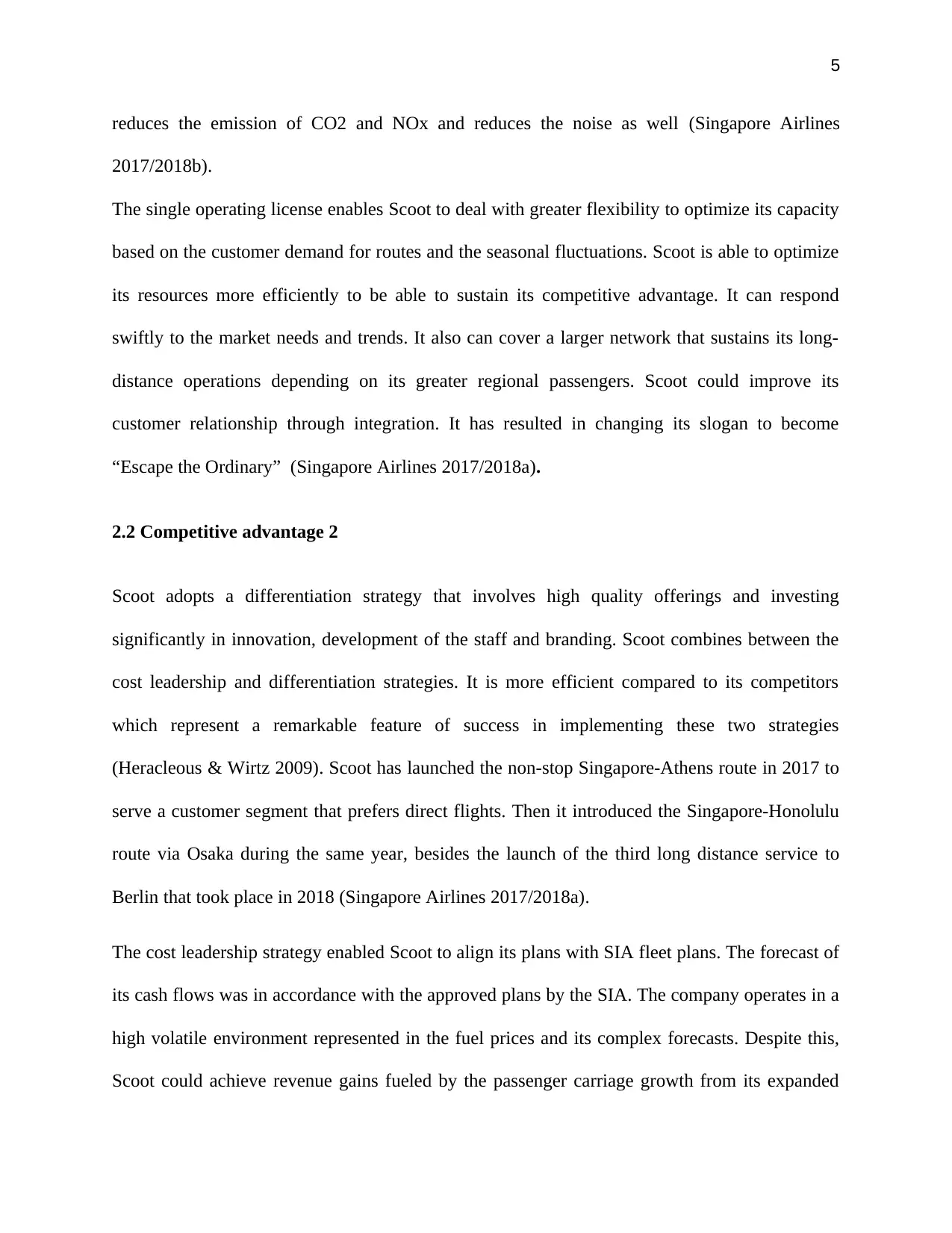
5
reduces the emission of CO2 and NOx and reduces the noise as well (Singapore Airlines
2017/2018b).
The single operating license enables Scoot to deal with greater flexibility to optimize its capacity
based on the customer demand for routes and the seasonal fluctuations. Scoot is able to optimize
its resources more efficiently to be able to sustain its competitive advantage. It can respond
swiftly to the market needs and trends. It also can cover a larger network that sustains its long-
distance operations depending on its greater regional passengers. Scoot could improve its
customer relationship through integration. It has resulted in changing its slogan to become
“Escape the Ordinary” (Singapore Airlines 2017/2018a).
2.2 Competitive advantage 2
Scoot adopts a differentiation strategy that involves high quality offerings and investing
significantly in innovation, development of the staff and branding. Scoot combines between the
cost leadership and differentiation strategies. It is more efficient compared to its competitors
which represent a remarkable feature of success in implementing these two strategies
(Heracleous & Wirtz 2009). Scoot has launched the non-stop Singapore-Athens route in 2017 to
serve a customer segment that prefers direct flights. Then it introduced the Singapore-Honolulu
route via Osaka during the same year, besides the launch of the third long distance service to
Berlin that took place in 2018 (Singapore Airlines 2017/2018a).
The cost leadership strategy enabled Scoot to align its plans with SIA fleet plans. The forecast of
its cash flows was in accordance with the approved plans by the SIA. The company operates in a
high volatile environment represented in the fuel prices and its complex forecasts. Despite this,
Scoot could achieve revenue gains fueled by the passenger carriage growth from its expanded
reduces the emission of CO2 and NOx and reduces the noise as well (Singapore Airlines
2017/2018b).
The single operating license enables Scoot to deal with greater flexibility to optimize its capacity
based on the customer demand for routes and the seasonal fluctuations. Scoot is able to optimize
its resources more efficiently to be able to sustain its competitive advantage. It can respond
swiftly to the market needs and trends. It also can cover a larger network that sustains its long-
distance operations depending on its greater regional passengers. Scoot could improve its
customer relationship through integration. It has resulted in changing its slogan to become
“Escape the Ordinary” (Singapore Airlines 2017/2018a).
2.2 Competitive advantage 2
Scoot adopts a differentiation strategy that involves high quality offerings and investing
significantly in innovation, development of the staff and branding. Scoot combines between the
cost leadership and differentiation strategies. It is more efficient compared to its competitors
which represent a remarkable feature of success in implementing these two strategies
(Heracleous & Wirtz 2009). Scoot has launched the non-stop Singapore-Athens route in 2017 to
serve a customer segment that prefers direct flights. Then it introduced the Singapore-Honolulu
route via Osaka during the same year, besides the launch of the third long distance service to
Berlin that took place in 2018 (Singapore Airlines 2017/2018a).
The cost leadership strategy enabled Scoot to align its plans with SIA fleet plans. The forecast of
its cash flows was in accordance with the approved plans by the SIA. The company operates in a
high volatile environment represented in the fuel prices and its complex forecasts. Despite this,
Scoot could achieve revenue gains fueled by the passenger carriage growth from its expanded
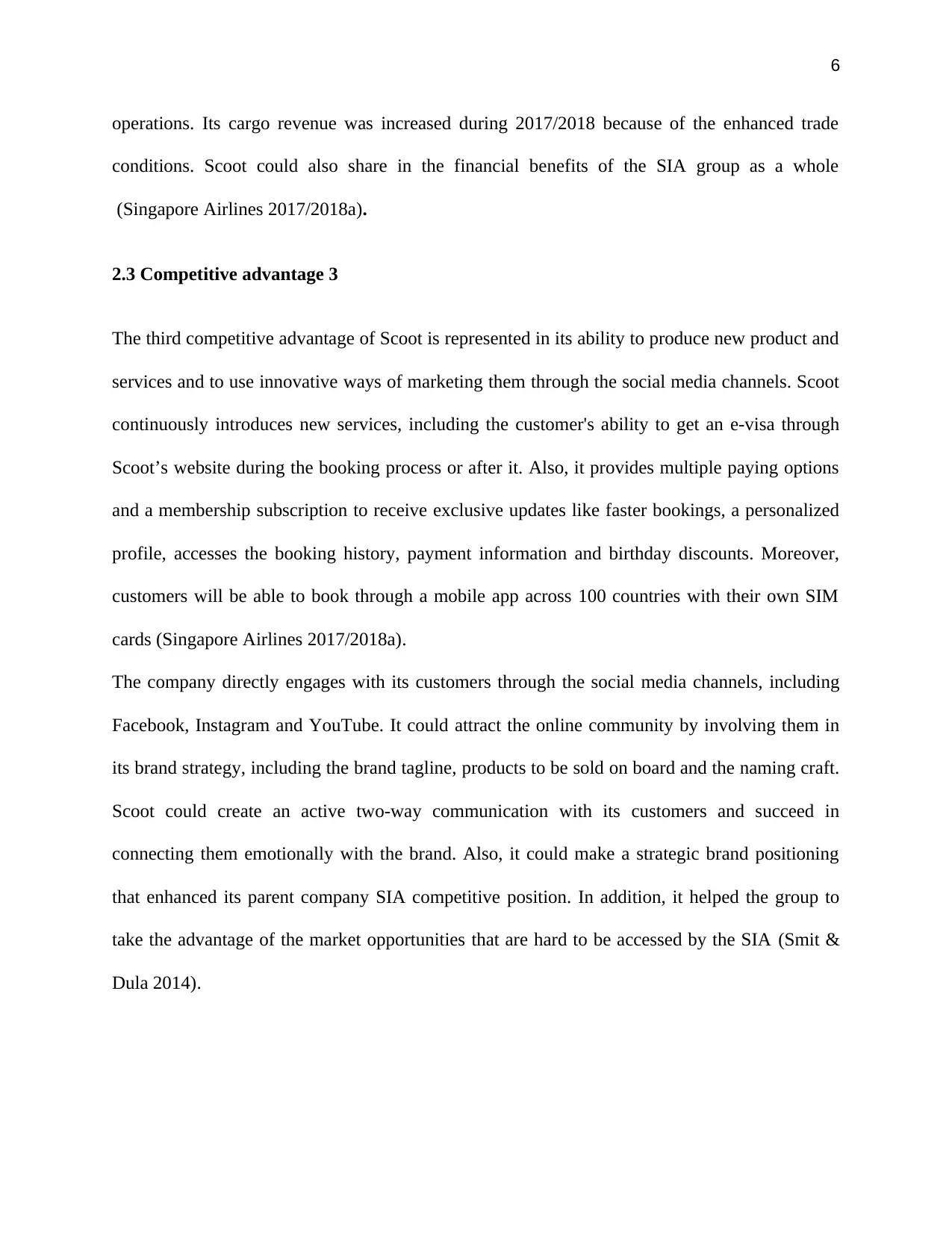
6
operations. Its cargo revenue was increased during 2017/2018 because of the enhanced trade
conditions. Scoot could also share in the financial benefits of the SIA group as a whole
(Singapore Airlines 2017/2018a).
2.3 Competitive advantage 3
The third competitive advantage of Scoot is represented in its ability to produce new product and
services and to use innovative ways of marketing them through the social media channels. Scoot
continuously introduces new services, including the customer's ability to get an e-visa through
Scoot’s website during the booking process or after it. Also, it provides multiple paying options
and a membership subscription to receive exclusive updates like faster bookings, a personalized
profile, accesses the booking history, payment information and birthday discounts. Moreover,
customers will be able to book through a mobile app across 100 countries with their own SIM
cards (Singapore Airlines 2017/2018a).
The company directly engages with its customers through the social media channels, including
Facebook, Instagram and YouTube. It could attract the online community by involving them in
its brand strategy, including the brand tagline, products to be sold on board and the naming craft.
Scoot could create an active two-way communication with its customers and succeed in
connecting them emotionally with the brand. Also, it could make a strategic brand positioning
that enhanced its parent company SIA competitive position. In addition, it helped the group to
take the advantage of the market opportunities that are hard to be accessed by the SIA (Smit &
Dula 2014).
operations. Its cargo revenue was increased during 2017/2018 because of the enhanced trade
conditions. Scoot could also share in the financial benefits of the SIA group as a whole
(Singapore Airlines 2017/2018a).
2.3 Competitive advantage 3
The third competitive advantage of Scoot is represented in its ability to produce new product and
services and to use innovative ways of marketing them through the social media channels. Scoot
continuously introduces new services, including the customer's ability to get an e-visa through
Scoot’s website during the booking process or after it. Also, it provides multiple paying options
and a membership subscription to receive exclusive updates like faster bookings, a personalized
profile, accesses the booking history, payment information and birthday discounts. Moreover,
customers will be able to book through a mobile app across 100 countries with their own SIM
cards (Singapore Airlines 2017/2018a).
The company directly engages with its customers through the social media channels, including
Facebook, Instagram and YouTube. It could attract the online community by involving them in
its brand strategy, including the brand tagline, products to be sold on board and the naming craft.
Scoot could create an active two-way communication with its customers and succeed in
connecting them emotionally with the brand. Also, it could make a strategic brand positioning
that enhanced its parent company SIA competitive position. In addition, it helped the group to
take the advantage of the market opportunities that are hard to be accessed by the SIA (Smit &
Dula 2014).
Paraphrase This Document
Need a fresh take? Get an instant paraphrase of this document with our AI Paraphraser
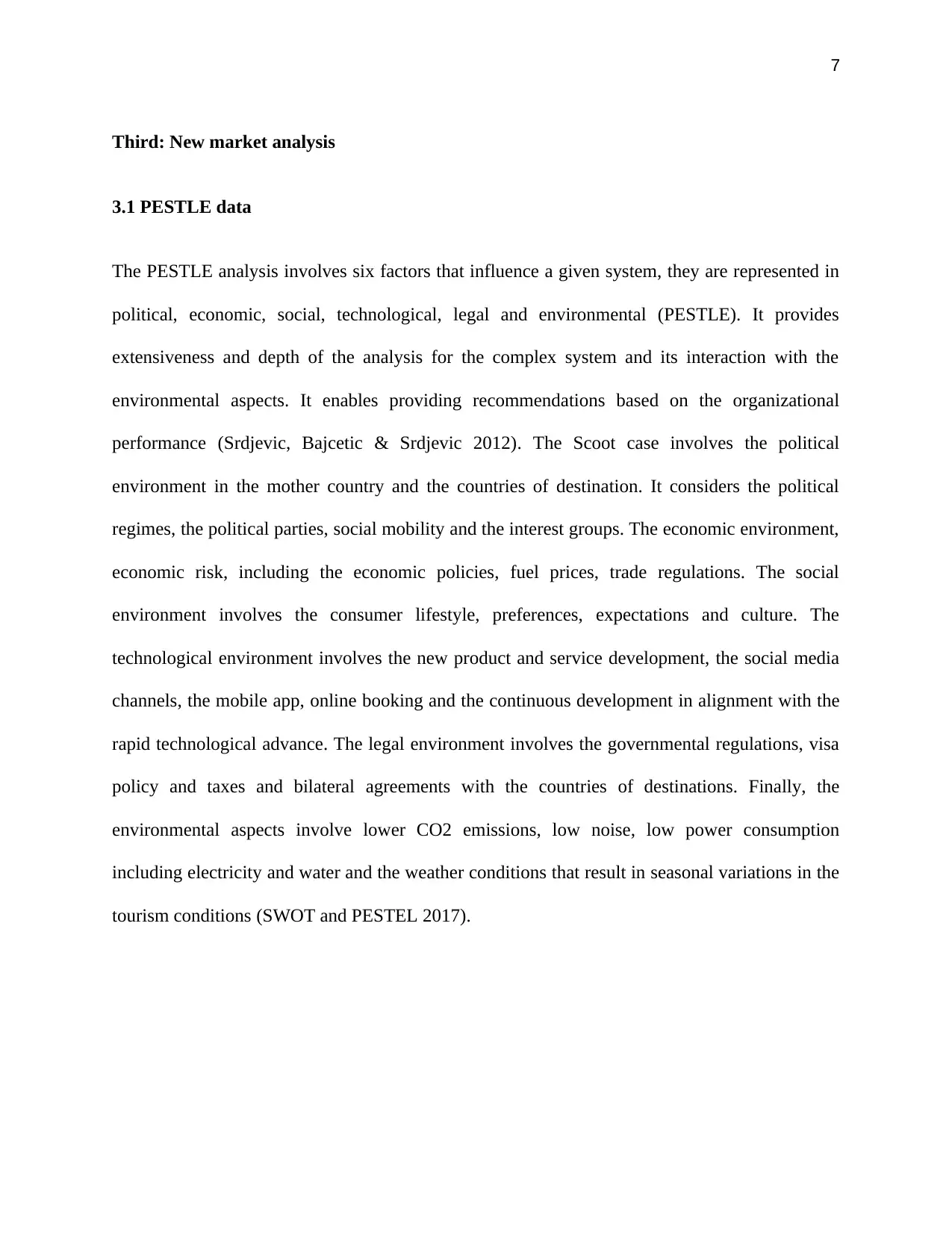
7
Third: New market analysis
3.1 PESTLE data
The PESTLE analysis involves six factors that influence a given system, they are represented in
political, economic, social, technological, legal and environmental (PESTLE). It provides
extensiveness and depth of the analysis for the complex system and its interaction with the
environmental aspects. It enables providing recommendations based on the organizational
performance (Srdjevic, Bajcetic & Srdjevic 2012). The Scoot case involves the political
environment in the mother country and the countries of destination. It considers the political
regimes, the political parties, social mobility and the interest groups. The economic environment,
economic risk, including the economic policies, fuel prices, trade regulations. The social
environment involves the consumer lifestyle, preferences, expectations and culture. The
technological environment involves the new product and service development, the social media
channels, the mobile app, online booking and the continuous development in alignment with the
rapid technological advance. The legal environment involves the governmental regulations, visa
policy and taxes and bilateral agreements with the countries of destinations. Finally, the
environmental aspects involve lower CO2 emissions, low noise, low power consumption
including electricity and water and the weather conditions that result in seasonal variations in the
tourism conditions (SWOT and PESTEL 2017).
Third: New market analysis
3.1 PESTLE data
The PESTLE analysis involves six factors that influence a given system, they are represented in
political, economic, social, technological, legal and environmental (PESTLE). It provides
extensiveness and depth of the analysis for the complex system and its interaction with the
environmental aspects. It enables providing recommendations based on the organizational
performance (Srdjevic, Bajcetic & Srdjevic 2012). The Scoot case involves the political
environment in the mother country and the countries of destination. It considers the political
regimes, the political parties, social mobility and the interest groups. The economic environment,
economic risk, including the economic policies, fuel prices, trade regulations. The social
environment involves the consumer lifestyle, preferences, expectations and culture. The
technological environment involves the new product and service development, the social media
channels, the mobile app, online booking and the continuous development in alignment with the
rapid technological advance. The legal environment involves the governmental regulations, visa
policy and taxes and bilateral agreements with the countries of destinations. Finally, the
environmental aspects involve lower CO2 emissions, low noise, low power consumption
including electricity and water and the weather conditions that result in seasonal variations in the
tourism conditions (SWOT and PESTEL 2017).
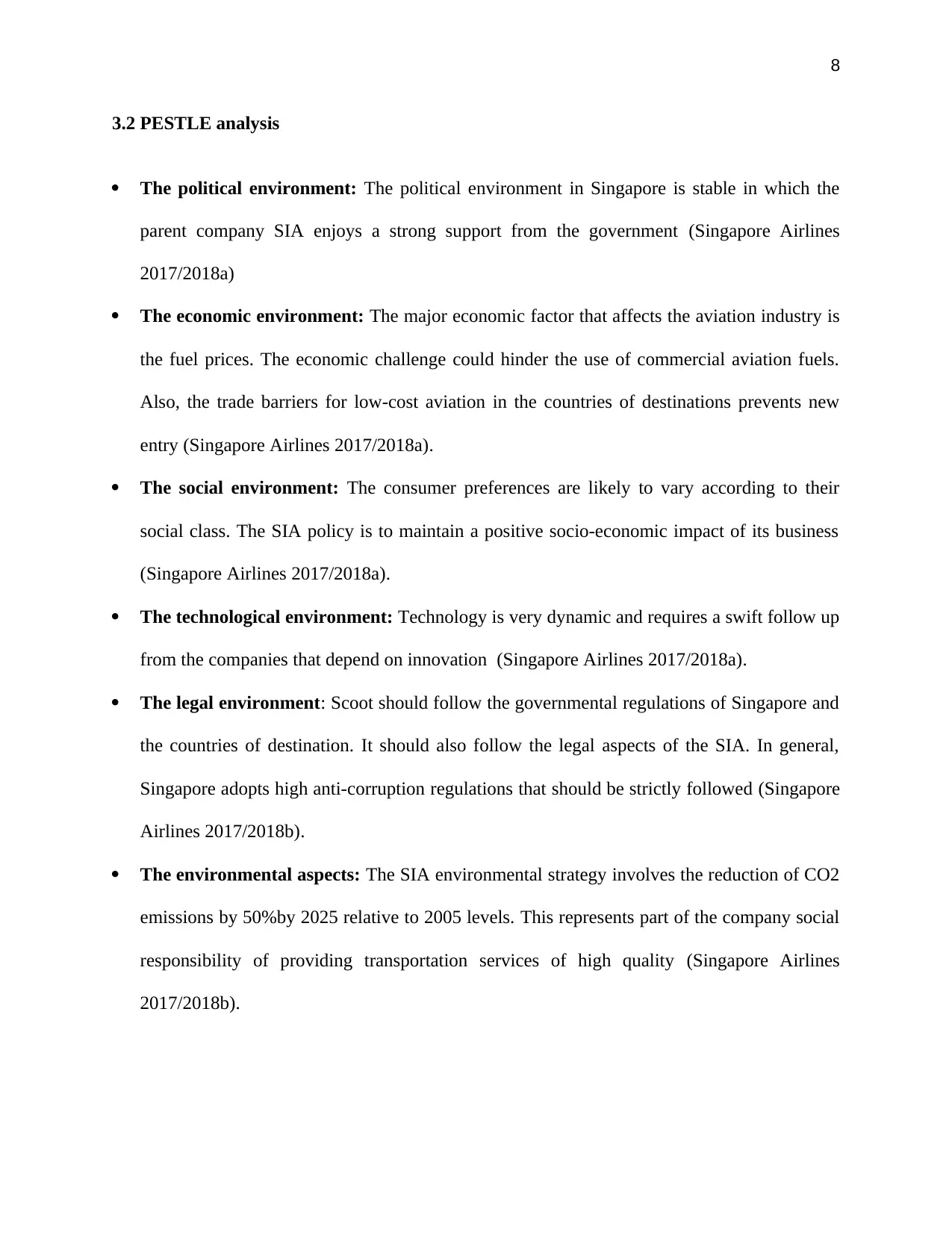
8
3.2 PESTLE analysis
The political environment: The political environment in Singapore is stable in which the
parent company SIA enjoys a strong support from the government (Singapore Airlines
2017/2018a)
The economic environment: The major economic factor that affects the aviation industry is
the fuel prices. The economic challenge could hinder the use of commercial aviation fuels.
Also, the trade barriers for low-cost aviation in the countries of destinations prevents new
entry (Singapore Airlines 2017/2018a).
The social environment: The consumer preferences are likely to vary according to their
social class. The SIA policy is to maintain a positive socio-economic impact of its business
(Singapore Airlines 2017/2018a).
The technological environment: Technology is very dynamic and requires a swift follow up
from the companies that depend on innovation (Singapore Airlines 2017/2018a).
The legal environment: Scoot should follow the governmental regulations of Singapore and
the countries of destination. It should also follow the legal aspects of the SIA. In general,
Singapore adopts high anti-corruption regulations that should be strictly followed (Singapore
Airlines 2017/2018b).
The environmental aspects: The SIA environmental strategy involves the reduction of CO2
emissions by 50%by 2025 relative to 2005 levels. This represents part of the company social
responsibility of providing transportation services of high quality (Singapore Airlines
2017/2018b).
3.2 PESTLE analysis
The political environment: The political environment in Singapore is stable in which the
parent company SIA enjoys a strong support from the government (Singapore Airlines
2017/2018a)
The economic environment: The major economic factor that affects the aviation industry is
the fuel prices. The economic challenge could hinder the use of commercial aviation fuels.
Also, the trade barriers for low-cost aviation in the countries of destinations prevents new
entry (Singapore Airlines 2017/2018a).
The social environment: The consumer preferences are likely to vary according to their
social class. The SIA policy is to maintain a positive socio-economic impact of its business
(Singapore Airlines 2017/2018a).
The technological environment: Technology is very dynamic and requires a swift follow up
from the companies that depend on innovation (Singapore Airlines 2017/2018a).
The legal environment: Scoot should follow the governmental regulations of Singapore and
the countries of destination. It should also follow the legal aspects of the SIA. In general,
Singapore adopts high anti-corruption regulations that should be strictly followed (Singapore
Airlines 2017/2018b).
The environmental aspects: The SIA environmental strategy involves the reduction of CO2
emissions by 50%by 2025 relative to 2005 levels. This represents part of the company social
responsibility of providing transportation services of high quality (Singapore Airlines
2017/2018b).
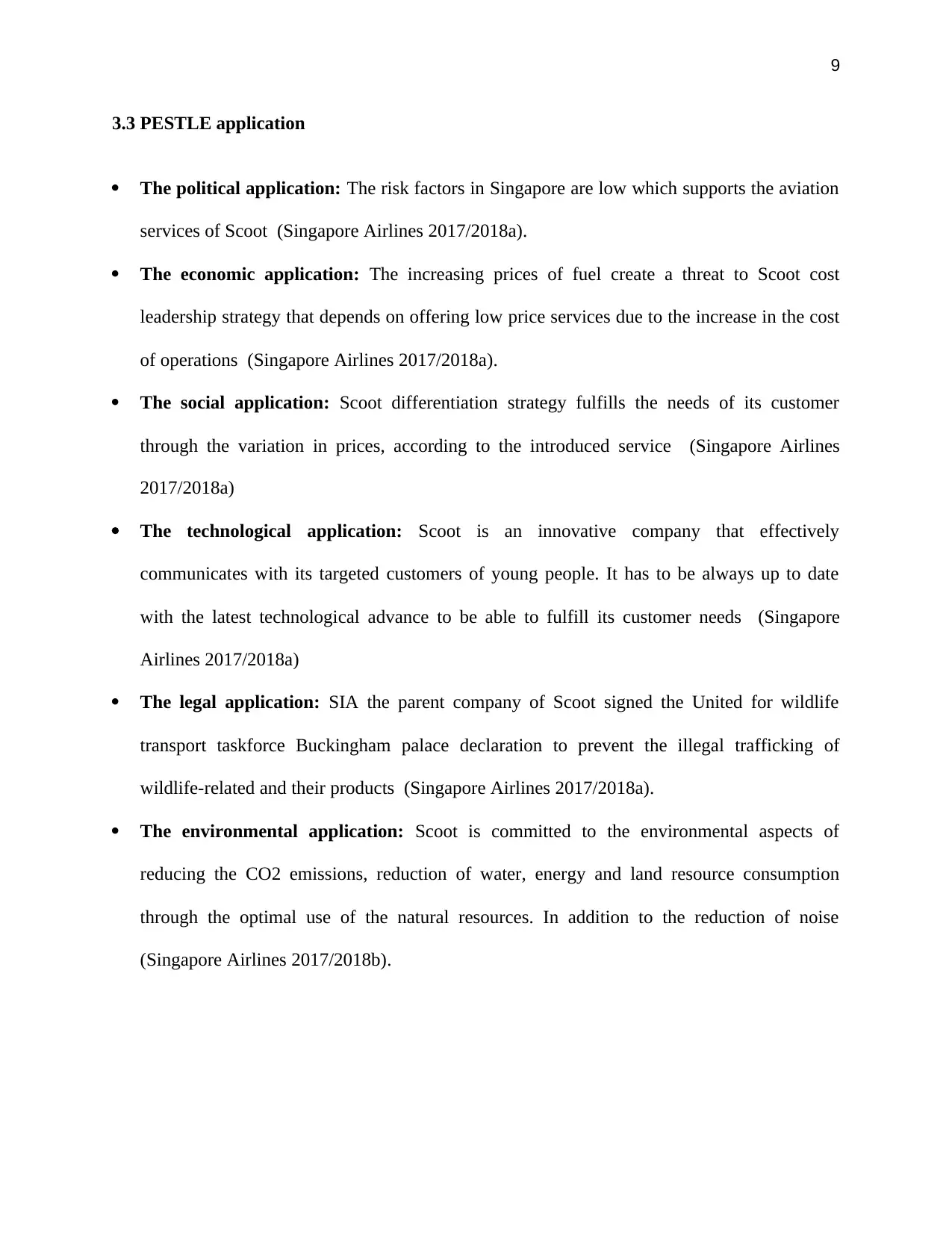
9
3.3 PESTLE application
The political application: The risk factors in Singapore are low which supports the aviation
services of Scoot (Singapore Airlines 2017/2018a).
The economic application: The increasing prices of fuel create a threat to Scoot cost
leadership strategy that depends on offering low price services due to the increase in the cost
of operations (Singapore Airlines 2017/2018a).
The social application: Scoot differentiation strategy fulfills the needs of its customer
through the variation in prices, according to the introduced service (Singapore Airlines
2017/2018a)
The technological application: Scoot is an innovative company that effectively
communicates with its targeted customers of young people. It has to be always up to date
with the latest technological advance to be able to fulfill its customer needs (Singapore
Airlines 2017/2018a)
The legal application: SIA the parent company of Scoot signed the United for wildlife
transport taskforce Buckingham palace declaration to prevent the illegal trafficking of
wildlife-related and their products (Singapore Airlines 2017/2018a).
The environmental application: Scoot is committed to the environmental aspects of
reducing the CO2 emissions, reduction of water, energy and land resource consumption
through the optimal use of the natural resources. In addition to the reduction of noise
(Singapore Airlines 2017/2018b).
3.3 PESTLE application
The political application: The risk factors in Singapore are low which supports the aviation
services of Scoot (Singapore Airlines 2017/2018a).
The economic application: The increasing prices of fuel create a threat to Scoot cost
leadership strategy that depends on offering low price services due to the increase in the cost
of operations (Singapore Airlines 2017/2018a).
The social application: Scoot differentiation strategy fulfills the needs of its customer
through the variation in prices, according to the introduced service (Singapore Airlines
2017/2018a)
The technological application: Scoot is an innovative company that effectively
communicates with its targeted customers of young people. It has to be always up to date
with the latest technological advance to be able to fulfill its customer needs (Singapore
Airlines 2017/2018a)
The legal application: SIA the parent company of Scoot signed the United for wildlife
transport taskforce Buckingham palace declaration to prevent the illegal trafficking of
wildlife-related and their products (Singapore Airlines 2017/2018a).
The environmental application: Scoot is committed to the environmental aspects of
reducing the CO2 emissions, reduction of water, energy and land resource consumption
through the optimal use of the natural resources. In addition to the reduction of noise
(Singapore Airlines 2017/2018b).
Secure Best Marks with AI Grader
Need help grading? Try our AI Grader for instant feedback on your assignments.
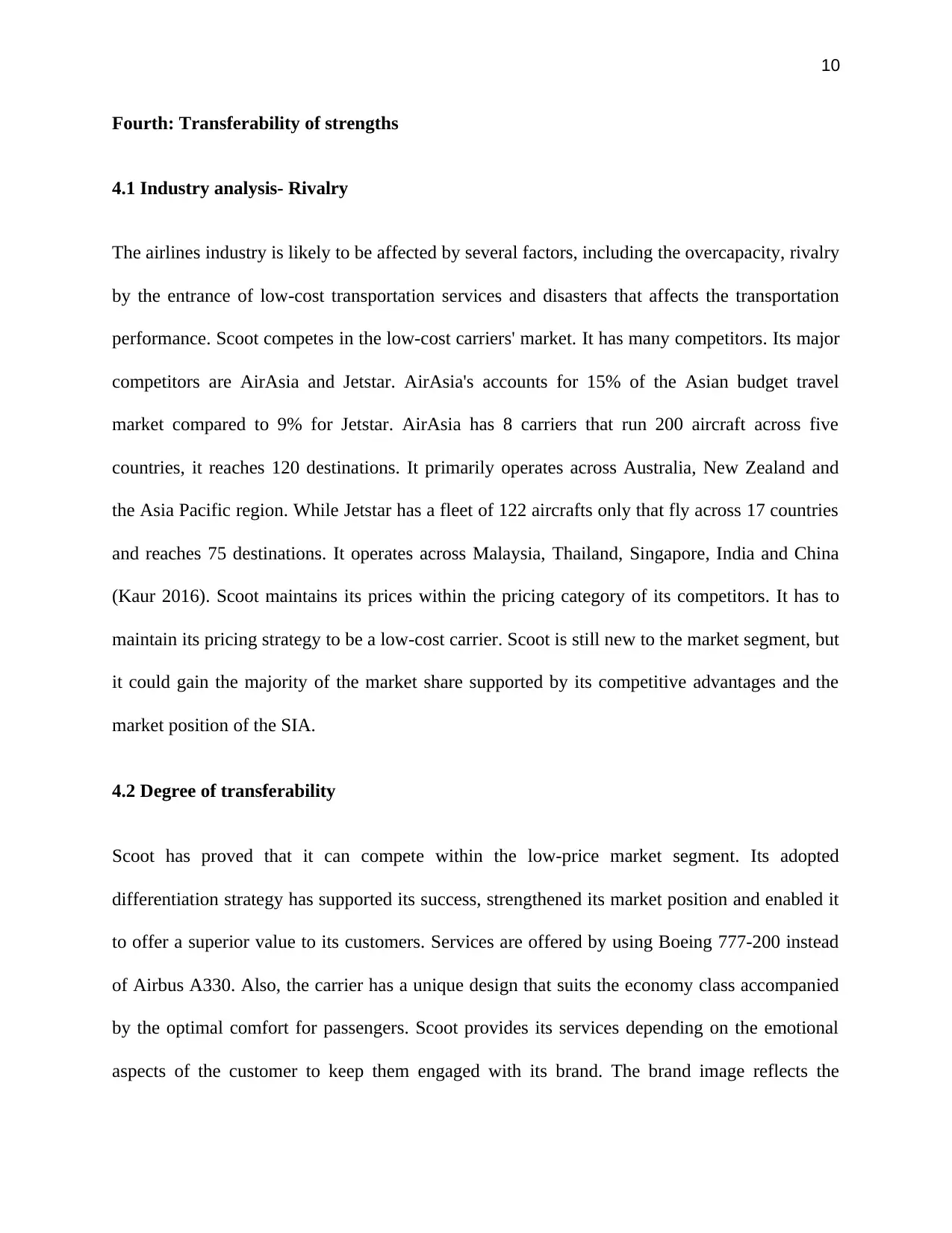
10
Fourth: Transferability of strengths
4.1 Industry analysis- Rivalry
The airlines industry is likely to be affected by several factors, including the overcapacity, rivalry
by the entrance of low-cost transportation services and disasters that affects the transportation
performance. Scoot competes in the low-cost carriers' market. It has many competitors. Its major
competitors are AirAsia and Jetstar. AirAsia's accounts for 15% of the Asian budget travel
market compared to 9% for Jetstar. AirAsia has 8 carriers that run 200 aircraft across five
countries, it reaches 120 destinations. It primarily operates across Australia, New Zealand and
the Asia Pacific region. While Jetstar has a fleet of 122 aircrafts only that fly across 17 countries
and reaches 75 destinations. It operates across Malaysia, Thailand, Singapore, India and China
(Kaur 2016). Scoot maintains its prices within the pricing category of its competitors. It has to
maintain its pricing strategy to be a low-cost carrier. Scoot is still new to the market segment, but
it could gain the majority of the market share supported by its competitive advantages and the
market position of the SIA.
4.2 Degree of transferability
Scoot has proved that it can compete within the low-price market segment. Its adopted
differentiation strategy has supported its success, strengthened its market position and enabled it
to offer a superior value to its customers. Services are offered by using Boeing 777-200 instead
of Airbus A330. Also, the carrier has a unique design that suits the economy class accompanied
by the optimal comfort for passengers. Scoot provides its services depending on the emotional
aspects of the customer to keep them engaged with its brand. The brand image reflects the
Fourth: Transferability of strengths
4.1 Industry analysis- Rivalry
The airlines industry is likely to be affected by several factors, including the overcapacity, rivalry
by the entrance of low-cost transportation services and disasters that affects the transportation
performance. Scoot competes in the low-cost carriers' market. It has many competitors. Its major
competitors are AirAsia and Jetstar. AirAsia's accounts for 15% of the Asian budget travel
market compared to 9% for Jetstar. AirAsia has 8 carriers that run 200 aircraft across five
countries, it reaches 120 destinations. It primarily operates across Australia, New Zealand and
the Asia Pacific region. While Jetstar has a fleet of 122 aircrafts only that fly across 17 countries
and reaches 75 destinations. It operates across Malaysia, Thailand, Singapore, India and China
(Kaur 2016). Scoot maintains its prices within the pricing category of its competitors. It has to
maintain its pricing strategy to be a low-cost carrier. Scoot is still new to the market segment, but
it could gain the majority of the market share supported by its competitive advantages and the
market position of the SIA.
4.2 Degree of transferability
Scoot has proved that it can compete within the low-price market segment. Its adopted
differentiation strategy has supported its success, strengthened its market position and enabled it
to offer a superior value to its customers. Services are offered by using Boeing 777-200 instead
of Airbus A330. Also, the carrier has a unique design that suits the economy class accompanied
by the optimal comfort for passengers. Scoot provides its services depending on the emotional
aspects of the customer to keep them engaged with its brand. The brand image reflects the
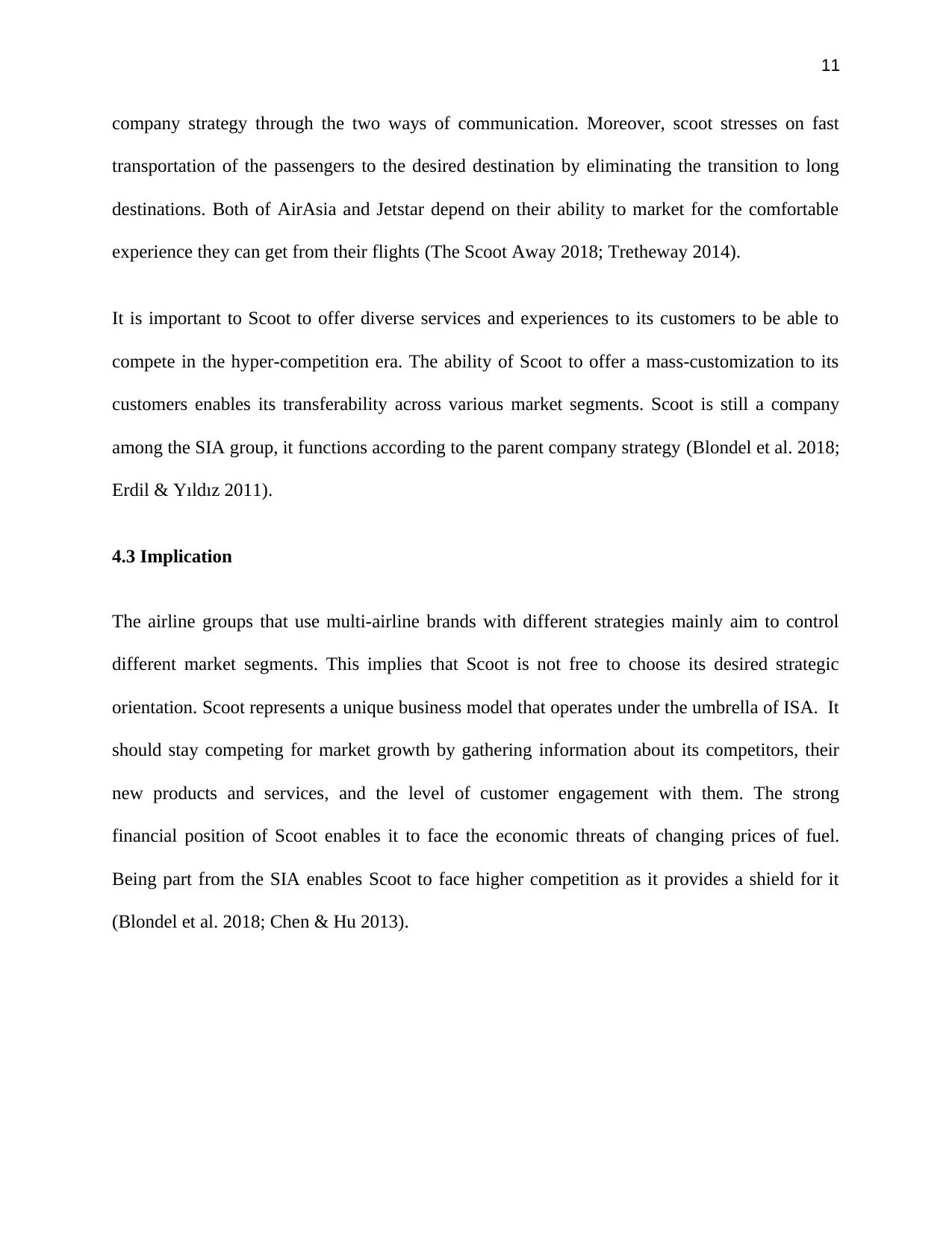
11
company strategy through the two ways of communication. Moreover, scoot stresses on fast
transportation of the passengers to the desired destination by eliminating the transition to long
destinations. Both of AirAsia and Jetstar depend on their ability to market for the comfortable
experience they can get from their flights (The Scoot Away 2018; Tretheway 2014).
It is important to Scoot to offer diverse services and experiences to its customers to be able to
compete in the hyper-competition era. The ability of Scoot to offer a mass-customization to its
customers enables its transferability across various market segments. Scoot is still a company
among the SIA group, it functions according to the parent company strategy (Blondel et al. 2018;
Erdil & Yıldız 2011).
4.3 Implication
The airline groups that use multi-airline brands with different strategies mainly aim to control
different market segments. This implies that Scoot is not free to choose its desired strategic
orientation. Scoot represents a unique business model that operates under the umbrella of ISA. It
should stay competing for market growth by gathering information about its competitors, their
new products and services, and the level of customer engagement with them. The strong
financial position of Scoot enables it to face the economic threats of changing prices of fuel.
Being part from the SIA enables Scoot to face higher competition as it provides a shield for it
(Blondel et al. 2018; Chen & Hu 2013).
company strategy through the two ways of communication. Moreover, scoot stresses on fast
transportation of the passengers to the desired destination by eliminating the transition to long
destinations. Both of AirAsia and Jetstar depend on their ability to market for the comfortable
experience they can get from their flights (The Scoot Away 2018; Tretheway 2014).
It is important to Scoot to offer diverse services and experiences to its customers to be able to
compete in the hyper-competition era. The ability of Scoot to offer a mass-customization to its
customers enables its transferability across various market segments. Scoot is still a company
among the SIA group, it functions according to the parent company strategy (Blondel et al. 2018;
Erdil & Yıldız 2011).
4.3 Implication
The airline groups that use multi-airline brands with different strategies mainly aim to control
different market segments. This implies that Scoot is not free to choose its desired strategic
orientation. Scoot represents a unique business model that operates under the umbrella of ISA. It
should stay competing for market growth by gathering information about its competitors, their
new products and services, and the level of customer engagement with them. The strong
financial position of Scoot enables it to face the economic threats of changing prices of fuel.
Being part from the SIA enables Scoot to face higher competition as it provides a shield for it
(Blondel et al. 2018; Chen & Hu 2013).
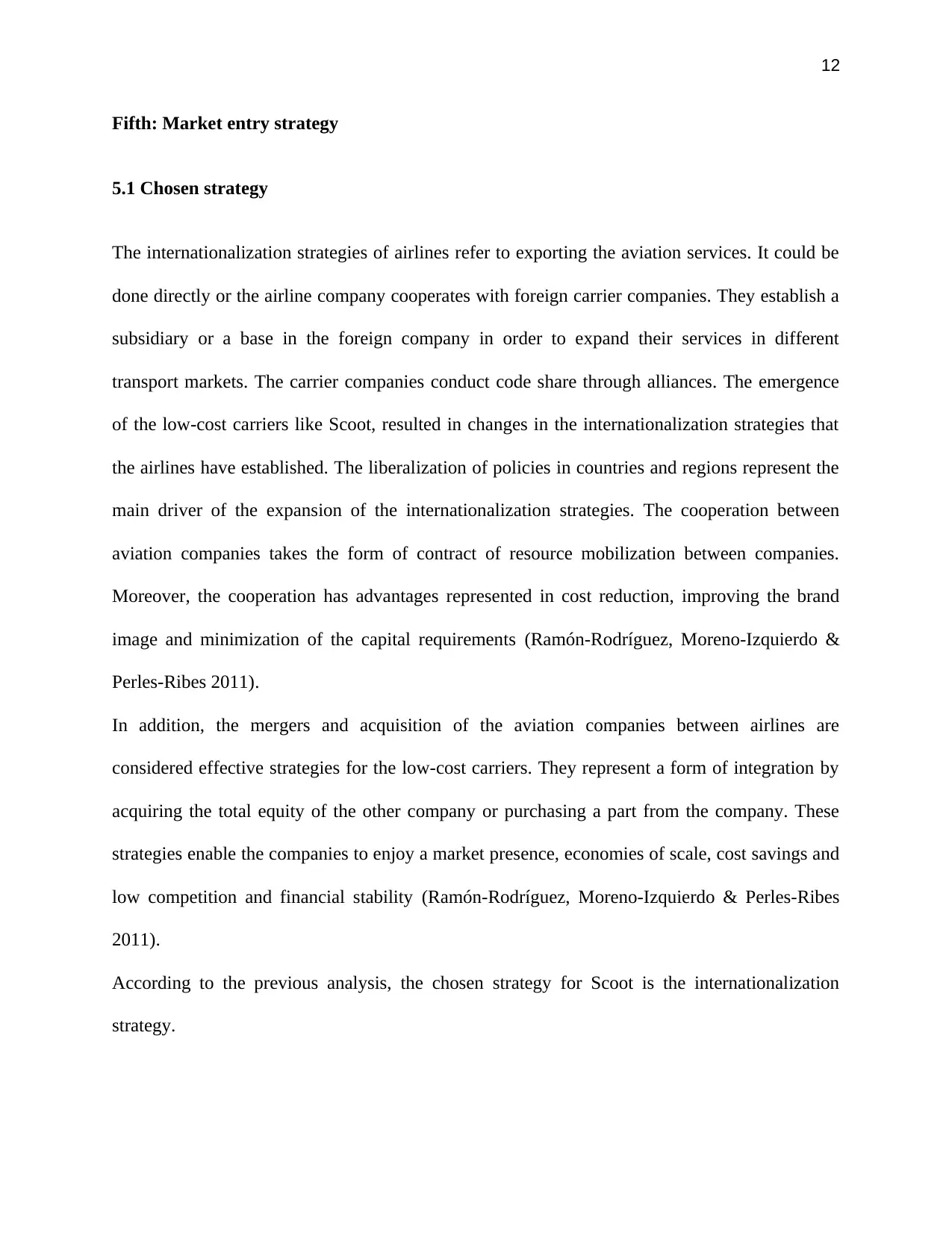
12
Fifth: Market entry strategy
5.1 Chosen strategy
The internationalization strategies of airlines refer to exporting the aviation services. It could be
done directly or the airline company cooperates with foreign carrier companies. They establish a
subsidiary or a base in the foreign company in order to expand their services in different
transport markets. The carrier companies conduct code share through alliances. The emergence
of the low-cost carriers like Scoot, resulted in changes in the internationalization strategies that
the airlines have established. The liberalization of policies in countries and regions represent the
main driver of the expansion of the internationalization strategies. The cooperation between
aviation companies takes the form of contract of resource mobilization between companies.
Moreover, the cooperation has advantages represented in cost reduction, improving the brand
image and minimization of the capital requirements (Ramón-Rodríguez, Moreno-Izquierdo &
Perles-Ribes 2011).
In addition, the mergers and acquisition of the aviation companies between airlines are
considered effective strategies for the low-cost carriers. They represent a form of integration by
acquiring the total equity of the other company or purchasing a part from the company. These
strategies enable the companies to enjoy a market presence, economies of scale, cost savings and
low competition and financial stability (Ramón-Rodríguez, Moreno-Izquierdo & Perles-Ribes
2011).
According to the previous analysis, the chosen strategy for Scoot is the internationalization
strategy.
Fifth: Market entry strategy
5.1 Chosen strategy
The internationalization strategies of airlines refer to exporting the aviation services. It could be
done directly or the airline company cooperates with foreign carrier companies. They establish a
subsidiary or a base in the foreign company in order to expand their services in different
transport markets. The carrier companies conduct code share through alliances. The emergence
of the low-cost carriers like Scoot, resulted in changes in the internationalization strategies that
the airlines have established. The liberalization of policies in countries and regions represent the
main driver of the expansion of the internationalization strategies. The cooperation between
aviation companies takes the form of contract of resource mobilization between companies.
Moreover, the cooperation has advantages represented in cost reduction, improving the brand
image and minimization of the capital requirements (Ramón-Rodríguez, Moreno-Izquierdo &
Perles-Ribes 2011).
In addition, the mergers and acquisition of the aviation companies between airlines are
considered effective strategies for the low-cost carriers. They represent a form of integration by
acquiring the total equity of the other company or purchasing a part from the company. These
strategies enable the companies to enjoy a market presence, economies of scale, cost savings and
low competition and financial stability (Ramón-Rodríguez, Moreno-Izquierdo & Perles-Ribes
2011).
According to the previous analysis, the chosen strategy for Scoot is the internationalization
strategy.
Paraphrase This Document
Need a fresh take? Get an instant paraphrase of this document with our AI Paraphraser
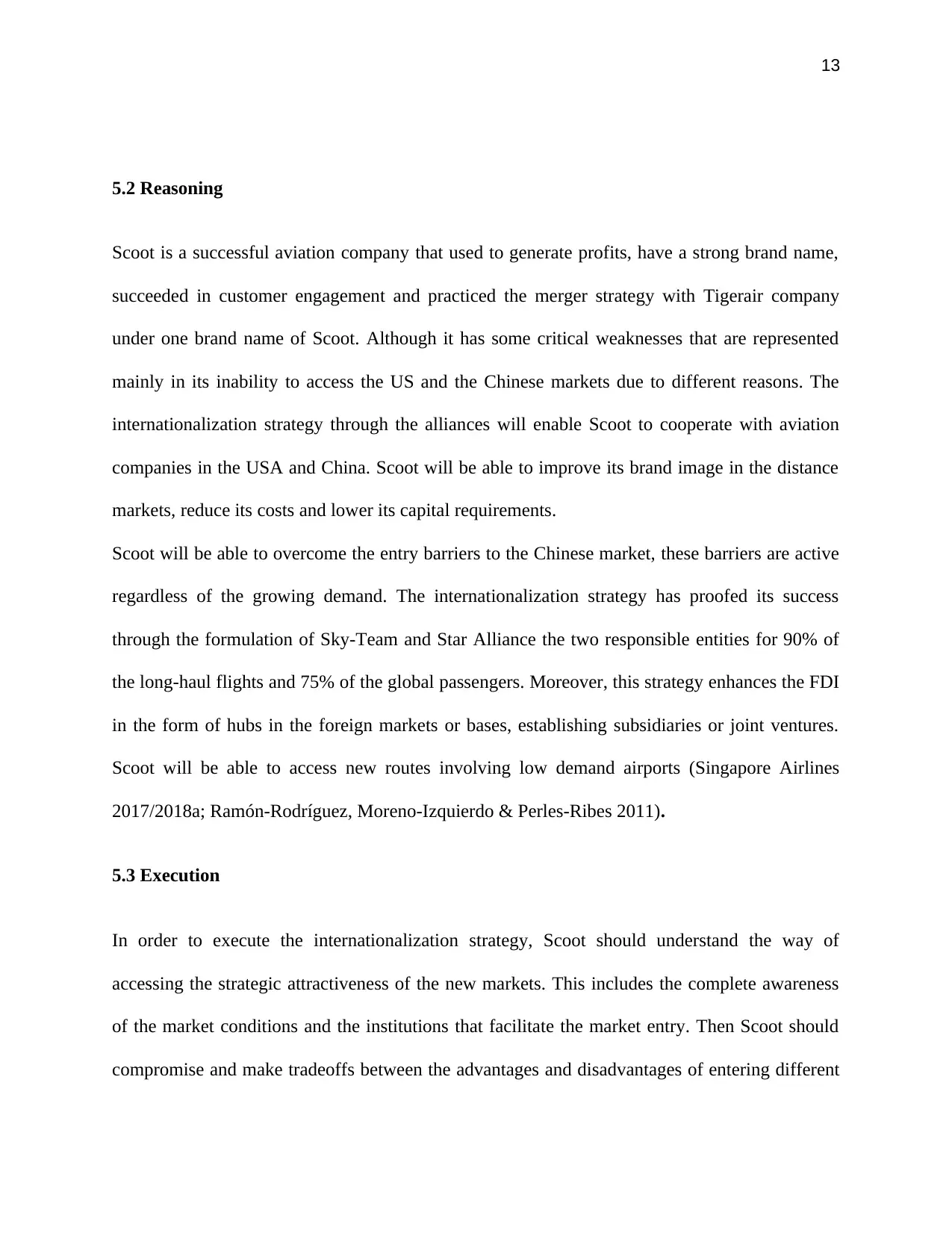
13
5.2 Reasoning
Scoot is a successful aviation company that used to generate profits, have a strong brand name,
succeeded in customer engagement and practiced the merger strategy with Tigerair company
under one brand name of Scoot. Although it has some critical weaknesses that are represented
mainly in its inability to access the US and the Chinese markets due to different reasons. The
internationalization strategy through the alliances will enable Scoot to cooperate with aviation
companies in the USA and China. Scoot will be able to improve its brand image in the distance
markets, reduce its costs and lower its capital requirements.
Scoot will be able to overcome the entry barriers to the Chinese market, these barriers are active
regardless of the growing demand. The internationalization strategy has proofed its success
through the formulation of Sky-Team and Star Alliance the two responsible entities for 90% of
the long-haul flights and 75% of the global passengers. Moreover, this strategy enhances the FDI
in the form of hubs in the foreign markets or bases, establishing subsidiaries or joint ventures.
Scoot will be able to access new routes involving low demand airports (Singapore Airlines
2017/2018a; Ramón-Rodríguez, Moreno-Izquierdo & Perles-Ribes 2011).
5.3 Execution
In order to execute the internationalization strategy, Scoot should understand the way of
accessing the strategic attractiveness of the new markets. This includes the complete awareness
of the market conditions and the institutions that facilitate the market entry. Then Scoot should
compromise and make tradeoffs between the advantages and disadvantages of entering different
5.2 Reasoning
Scoot is a successful aviation company that used to generate profits, have a strong brand name,
succeeded in customer engagement and practiced the merger strategy with Tigerair company
under one brand name of Scoot. Although it has some critical weaknesses that are represented
mainly in its inability to access the US and the Chinese markets due to different reasons. The
internationalization strategy through the alliances will enable Scoot to cooperate with aviation
companies in the USA and China. Scoot will be able to improve its brand image in the distance
markets, reduce its costs and lower its capital requirements.
Scoot will be able to overcome the entry barriers to the Chinese market, these barriers are active
regardless of the growing demand. The internationalization strategy has proofed its success
through the formulation of Sky-Team and Star Alliance the two responsible entities for 90% of
the long-haul flights and 75% of the global passengers. Moreover, this strategy enhances the FDI
in the form of hubs in the foreign markets or bases, establishing subsidiaries or joint ventures.
Scoot will be able to access new routes involving low demand airports (Singapore Airlines
2017/2018a; Ramón-Rodríguez, Moreno-Izquierdo & Perles-Ribes 2011).
5.3 Execution
In order to execute the internationalization strategy, Scoot should understand the way of
accessing the strategic attractiveness of the new markets. This includes the complete awareness
of the market conditions and the institutions that facilitate the market entry. Then Scoot should
compromise and make tradeoffs between the advantages and disadvantages of entering different
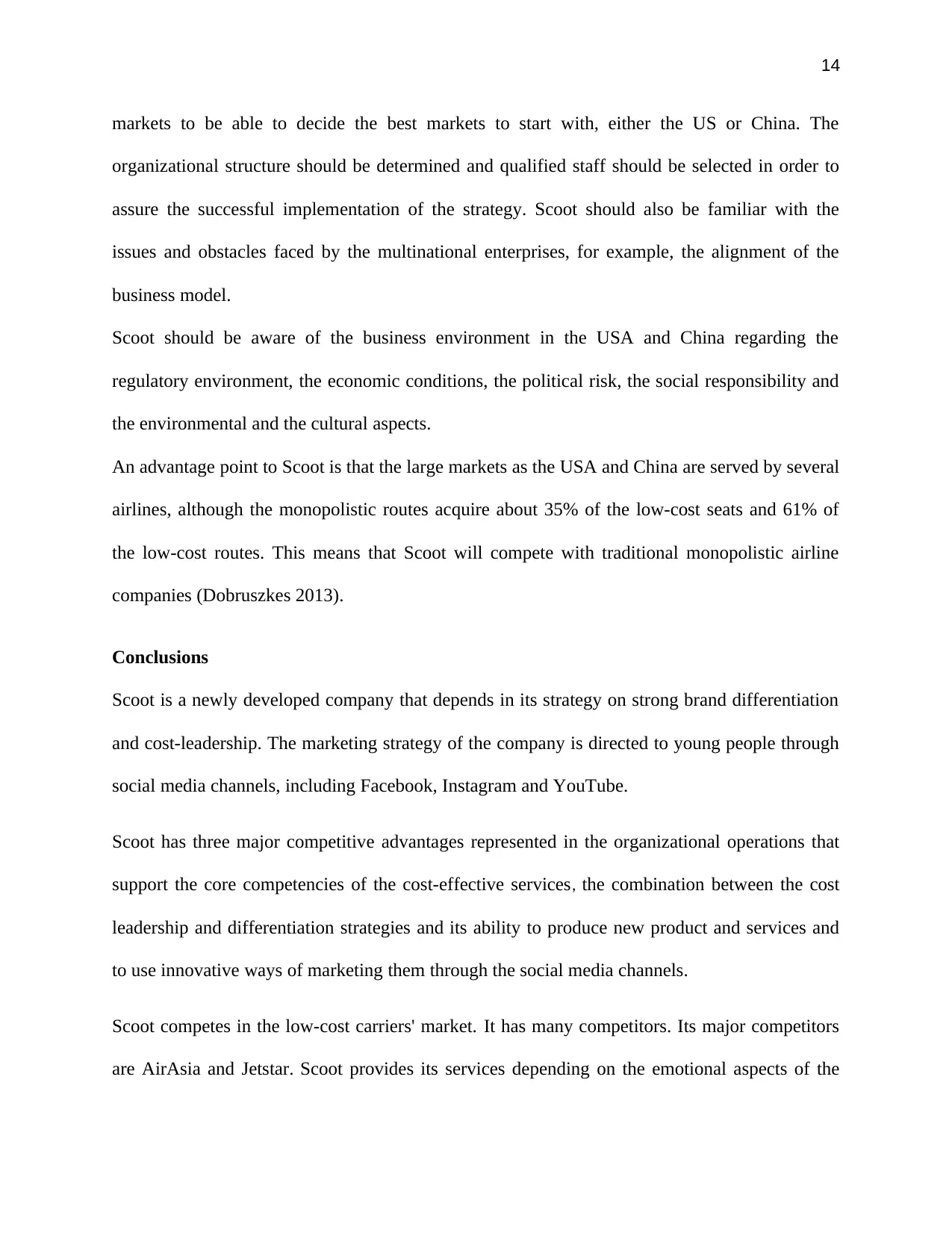
14
markets to be able to decide the best markets to start with, either the US or China. The
organizational structure should be determined and qualified staff should be selected in order to
assure the successful implementation of the strategy. Scoot should also be familiar with the
issues and obstacles faced by the multinational enterprises, for example, the alignment of the
business model.
Scoot should be aware of the business environment in the USA and China regarding the
regulatory environment, the economic conditions, the political risk, the social responsibility and
the environmental and the cultural aspects.
An advantage point to Scoot is that the large markets as the USA and China are served by several
airlines, although the monopolistic routes acquire about 35% of the low-cost seats and 61% of
the low-cost routes. This means that Scoot will compete with traditional monopolistic airline
companies (Dobruszkes 2013).
Conclusions
Scoot is a newly developed company that depends in its strategy on strong brand differentiation
and cost-leadership. The marketing strategy of the company is directed to young people through
social media channels, including Facebook, Instagram and YouTube.
Scoot has three major competitive advantages represented in the organizational operations that
support the core competencies of the cost-effective services, the combination between the cost
leadership and differentiation strategies and its ability to produce new product and services and
to use innovative ways of marketing them through the social media channels.
Scoot competes in the low-cost carriers' market. It has many competitors. Its major competitors
are AirAsia and Jetstar. Scoot provides its services depending on the emotional aspects of the
markets to be able to decide the best markets to start with, either the US or China. The
organizational structure should be determined and qualified staff should be selected in order to
assure the successful implementation of the strategy. Scoot should also be familiar with the
issues and obstacles faced by the multinational enterprises, for example, the alignment of the
business model.
Scoot should be aware of the business environment in the USA and China regarding the
regulatory environment, the economic conditions, the political risk, the social responsibility and
the environmental and the cultural aspects.
An advantage point to Scoot is that the large markets as the USA and China are served by several
airlines, although the monopolistic routes acquire about 35% of the low-cost seats and 61% of
the low-cost routes. This means that Scoot will compete with traditional monopolistic airline
companies (Dobruszkes 2013).
Conclusions
Scoot is a newly developed company that depends in its strategy on strong brand differentiation
and cost-leadership. The marketing strategy of the company is directed to young people through
social media channels, including Facebook, Instagram and YouTube.
Scoot has three major competitive advantages represented in the organizational operations that
support the core competencies of the cost-effective services, the combination between the cost
leadership and differentiation strategies and its ability to produce new product and services and
to use innovative ways of marketing them through the social media channels.
Scoot competes in the low-cost carriers' market. It has many competitors. Its major competitors
are AirAsia and Jetstar. Scoot provides its services depending on the emotional aspects of the
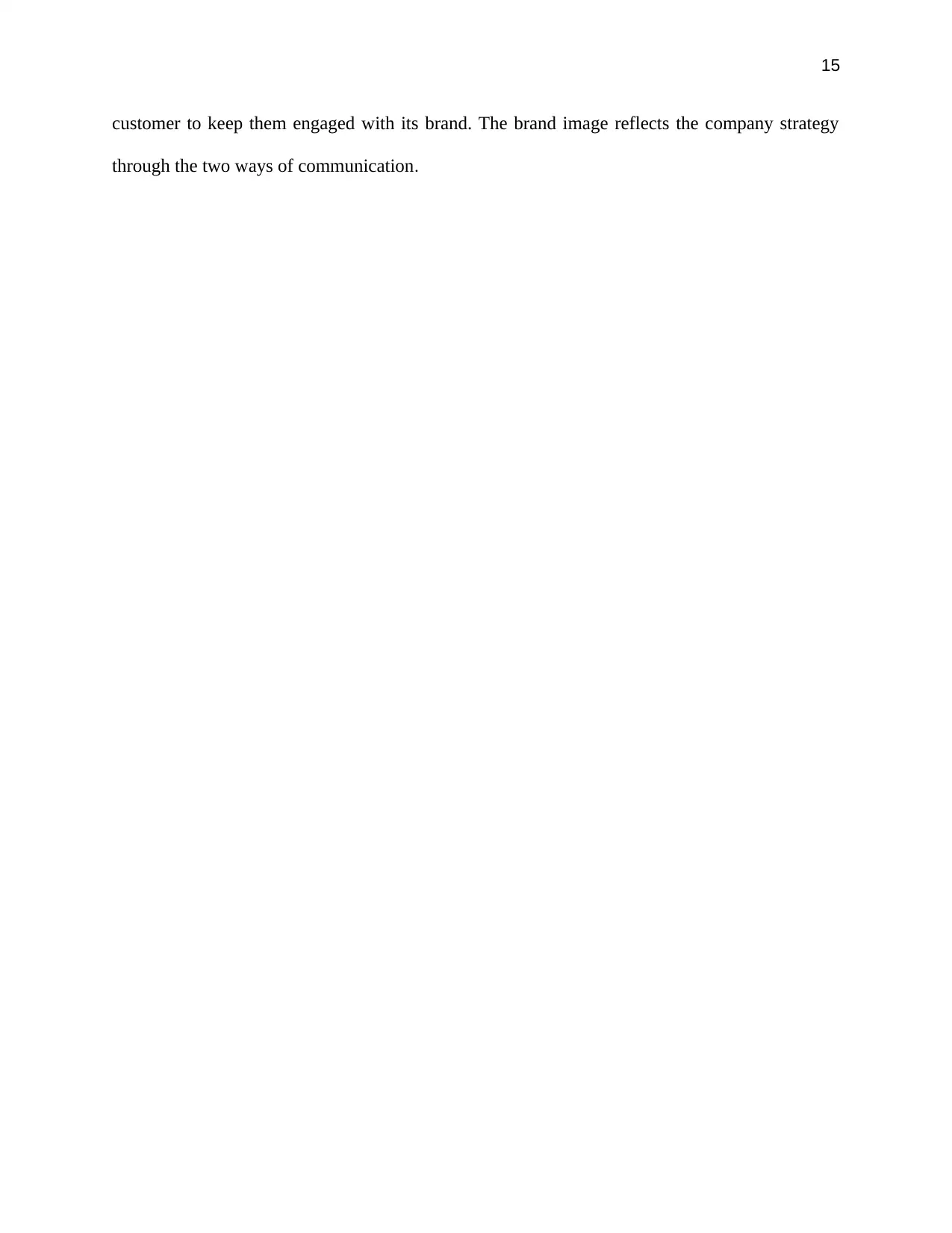
15
customer to keep them engaged with its brand. The brand image reflects the company strategy
through the two ways of communication.
customer to keep them engaged with its brand. The brand image reflects the company strategy
through the two ways of communication.
Secure Best Marks with AI Grader
Need help grading? Try our AI Grader for instant feedback on your assignments.
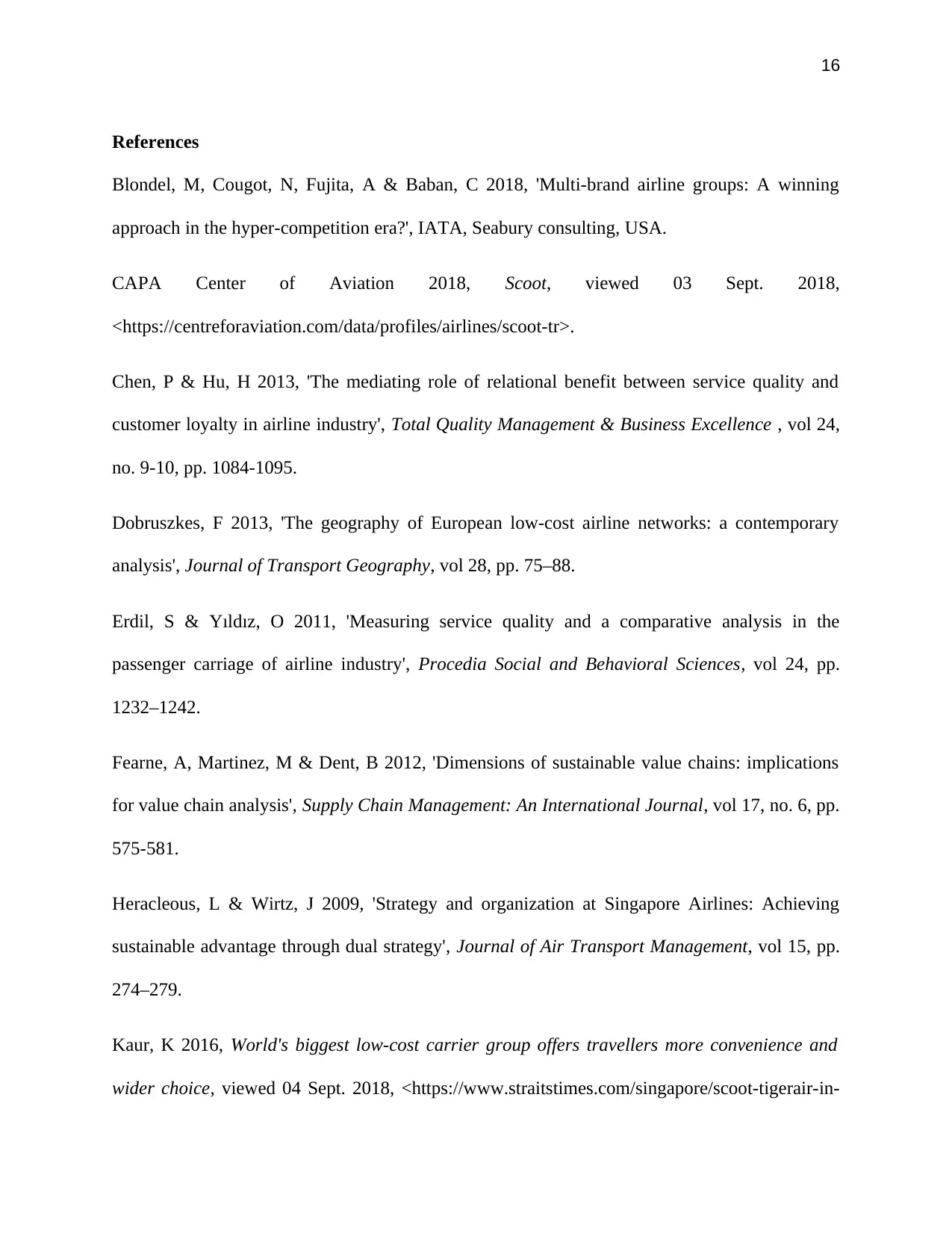
16
References
Blondel, M, Cougot, N, Fujita, A & Baban, C 2018, 'Multi-brand airline groups: A winning
approach in the hyper-competition era?', IATA, Seabury consulting, USA.
CAPA Center of Aviation 2018, Scoot, viewed 03 Sept. 2018,
<https://centreforaviation.com/data/profiles/airlines/scoot-tr>.
Chen, P & Hu, H 2013, 'The mediating role of relational benefit between service quality and
customer loyalty in airline industry', Total Quality Management & Business Excellence , vol 24,
no. 9-10, pp. 1084-1095.
Dobruszkes, F 2013, 'The geography of European low-cost airline networks: a contemporary
analysis', Journal of Transport Geography, vol 28, pp. 75–88.
Erdil, S & Yıldız, O 2011, 'Measuring service quality and a comparative analysis in the
passenger carriage of airline industry', Procedia Social and Behavioral Sciences, vol 24, pp.
1232–1242.
Fearne, A, Martinez, M & Dent, B 2012, 'Dimensions of sustainable value chains: implications
for value chain analysis', Supply Chain Management: An International Journal, vol 17, no. 6, pp.
575-581.
Heracleous, L & Wirtz, J 2009, 'Strategy and organization at Singapore Airlines: Achieving
sustainable advantage through dual strategy', Journal of Air Transport Management, vol 15, pp.
274–279.
Kaur, K 2016, World's biggest low-cost carrier group offers travellers more convenience and
wider choice, viewed 04 Sept. 2018, <https://www.straitstimes.com/singapore/scoot-tigerair-in-
References
Blondel, M, Cougot, N, Fujita, A & Baban, C 2018, 'Multi-brand airline groups: A winning
approach in the hyper-competition era?', IATA, Seabury consulting, USA.
CAPA Center of Aviation 2018, Scoot, viewed 03 Sept. 2018,
<https://centreforaviation.com/data/profiles/airlines/scoot-tr>.
Chen, P & Hu, H 2013, 'The mediating role of relational benefit between service quality and
customer loyalty in airline industry', Total Quality Management & Business Excellence , vol 24,
no. 9-10, pp. 1084-1095.
Dobruszkes, F 2013, 'The geography of European low-cost airline networks: a contemporary
analysis', Journal of Transport Geography, vol 28, pp. 75–88.
Erdil, S & Yıldız, O 2011, 'Measuring service quality and a comparative analysis in the
passenger carriage of airline industry', Procedia Social and Behavioral Sciences, vol 24, pp.
1232–1242.
Fearne, A, Martinez, M & Dent, B 2012, 'Dimensions of sustainable value chains: implications
for value chain analysis', Supply Chain Management: An International Journal, vol 17, no. 6, pp.
575-581.
Heracleous, L & Wirtz, J 2009, 'Strategy and organization at Singapore Airlines: Achieving
sustainable advantage through dual strategy', Journal of Air Transport Management, vol 15, pp.
274–279.
Kaur, K 2016, World's biggest low-cost carrier group offers travellers more convenience and
wider choice, viewed 04 Sept. 2018, <https://www.straitstimes.com/singapore/scoot-tigerair-in-
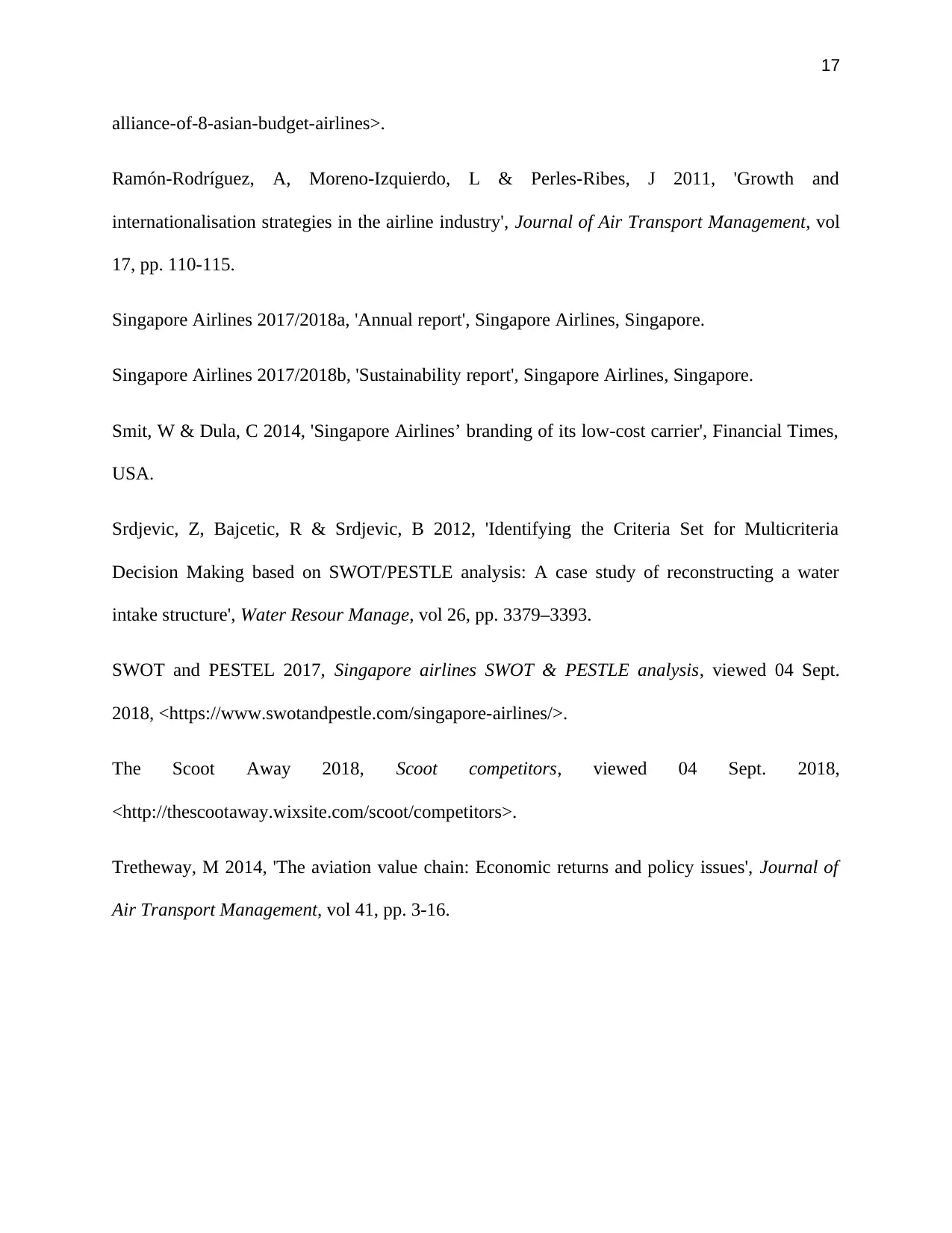
17
alliance-of-8-asian-budget-airlines>.
Ramón-Rodríguez, A, Moreno-Izquierdo, L & Perles-Ribes, J 2011, 'Growth and
internationalisation strategies in the airline industry', Journal of Air Transport Management, vol
17, pp. 110-115.
Singapore Airlines 2017/2018a, 'Annual report', Singapore Airlines, Singapore.
Singapore Airlines 2017/2018b, 'Sustainability report', Singapore Airlines, Singapore.
Smit, W & Dula, C 2014, 'Singapore Airlines’ branding of its low-cost carrier', Financial Times,
USA.
Srdjevic, Z, Bajcetic, R & Srdjevic, B 2012, 'Identifying the Criteria Set for Multicriteria
Decision Making based on SWOT/PESTLE analysis: A case study of reconstructing a water
intake structure', Water Resour Manage, vol 26, pp. 3379–3393.
SWOT and PESTEL 2017, Singapore airlines SWOT & PESTLE analysis, viewed 04 Sept.
2018, <https://www.swotandpestle.com/singapore-airlines/>.
The Scoot Away 2018, Scoot competitors, viewed 04 Sept. 2018,
<http://thescootaway.wixsite.com/scoot/competitors>.
Tretheway, M 2014, 'The aviation value chain: Economic returns and policy issues', Journal of
Air Transport Management, vol 41, pp. 3-16.
alliance-of-8-asian-budget-airlines>.
Ramón-Rodríguez, A, Moreno-Izquierdo, L & Perles-Ribes, J 2011, 'Growth and
internationalisation strategies in the airline industry', Journal of Air Transport Management, vol
17, pp. 110-115.
Singapore Airlines 2017/2018a, 'Annual report', Singapore Airlines, Singapore.
Singapore Airlines 2017/2018b, 'Sustainability report', Singapore Airlines, Singapore.
Smit, W & Dula, C 2014, 'Singapore Airlines’ branding of its low-cost carrier', Financial Times,
USA.
Srdjevic, Z, Bajcetic, R & Srdjevic, B 2012, 'Identifying the Criteria Set for Multicriteria
Decision Making based on SWOT/PESTLE analysis: A case study of reconstructing a water
intake structure', Water Resour Manage, vol 26, pp. 3379–3393.
SWOT and PESTEL 2017, Singapore airlines SWOT & PESTLE analysis, viewed 04 Sept.
2018, <https://www.swotandpestle.com/singapore-airlines/>.
The Scoot Away 2018, Scoot competitors, viewed 04 Sept. 2018,
<http://thescootaway.wixsite.com/scoot/competitors>.
Tretheway, M 2014, 'The aviation value chain: Economic returns and policy issues', Journal of
Air Transport Management, vol 41, pp. 3-16.
1 out of 18
Related Documents
Your All-in-One AI-Powered Toolkit for Academic Success.
+13062052269
info@desklib.com
Available 24*7 on WhatsApp / Email
![[object Object]](/_next/static/media/star-bottom.7253800d.svg)
Unlock your academic potential
© 2024 | Zucol Services PVT LTD | All rights reserved.





